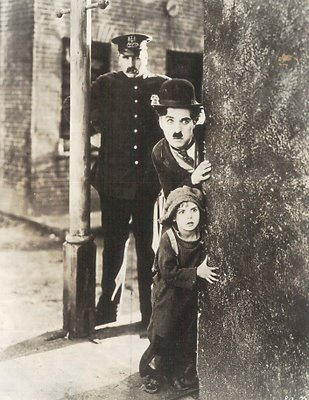
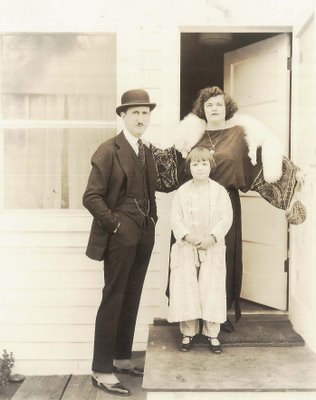
Child Star Supreme --- Jackie Coogan
Jackie Coogan is the only motion picture star I’m aware of who actively participated in a lynching. Perhaps there were others, but after all, this is not something you would find in official studio bios. Jackie was also the first international child phenomenon. You might even go beyond that and call him a religious figure. No one of our generation could imagine the level of stardom this kid enjoyed (and by all accounts, he really did enjoy it, even if the thing did come crashing down later). Jackie rang the opening bell for an age of child worship which would transform the way society viewed its young. The fact he was idolized and pampered on a public stage while being systematically robbed and exploited at home was an irony that would stun a nation when headlines broke on April 11, 1938. Jackie in his heyday was an adorable puppet for a low grade set of vaudeville parents who lucked into siring a money machine screens had not known to that time. His mother was called Lillian. She once silenced diners by referring to herself as "the goose that laid the golden egg." The father was Jack, Sr. He was stage flotsam with a line of cruel practical jokes and baggage familiar to his trade --- liquor, gambling, reckless spending. With role models like these, what chance did Jackie ever have?
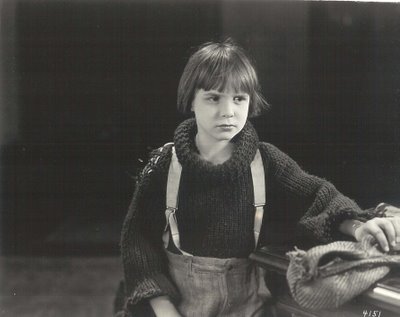

Charlie Chaplin should have had a percentage of Jackie, because he sure enough invented this child. In fact, it was Charlie’s Kid character that J.C. would continue to play, with only slight variation, for the rest of his boy years, even down to the costume. It’s a testament to Chaplin genius that the public was willing to continue buying his creation so long after he stopped manufacturing it. Opportunist producers like Sol Lesser (he of much later Tarzan films for RKO) snapped up Jackie as soon as The Kid made the six-year old a worldwide sensation, afterward a simple matter of recycling formula that had worked for Chaplin ... comedy, pathos, Coogan the beleaguered child, whatever kept trains on track. Some say Jackie represented past plight of war orphans. Some put forth a theory that merchandising, at least as it’s directed toward children, saw birth in Jackie Coogan. Others claimed our embrace of Jackie enabled shuck of quaint Victorian concept re children seen and not heard. Throw in popularity a result of increased leisure time thanks to the machine age and availability of labor saving devices, then proceed to an Ivy League Master’s program and your own Jackie Coogan Cultural Studies Department.
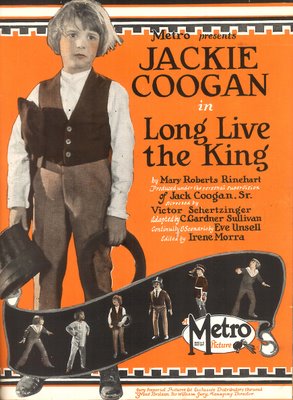
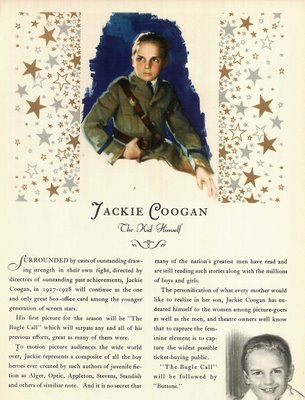
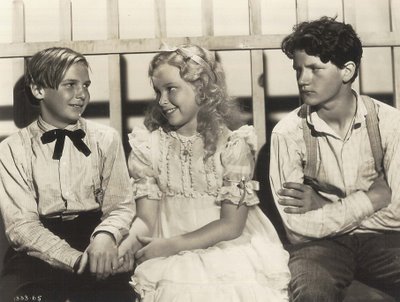
They found out quick that you couldn’t take Jackie out in public. Lillian carried him along to a department store two-for-one and wound up with three thousand crazed shoppers swarmed over the hapless child. It took police in force to extricate them. By the time he signed with Metro in 1923, Jackie (or I should say his parents) were scoring $1.35 million a year. A lot of that came from product endorsements. In those days, there were Jackie toys and dolls in abundance. His cherubic face graced song sheet covers for the likes of I’m Just A Lonely Little Kid on your upright piano. Jackie kept company with Douglas Fairbanks, Rudolph Valentino, Babe Ruth --- all the biggest names. They were thrilled to be seen with him. Dad's society was ruder, and it was these that really influenced the boy. Jack, Sr. brought his son along for drinking bouts with W.C. Fields, Ben Turpin, Roscoe Arbuckle --- nobody’s idea of fit companions for a growing lad. Wicked Uncle Bill gave Jackie a crash course in the use of profanities, which the child later applied in polite conversation, causing no end of embarrassment for studio publicists. The lowdown parental house of cards finally collapsed when Lillian pursued furtive relations with one Arthur Bernstein, lately a business manager for the Jackie Coogan Corporation, itself a clearing house to convert Jackie’s earnings to his parent's own use and gratification. While these bejeweled parasites drove fancy roadsters and hovered over roulette wheels, Jackie worked twelve-hour days, six-day weeks. Even after the movie thing faded, they had him hustling from a music hall stage in England, where big money could still be had for star names, even those on the wane. The awkward age dealt a growth spurt that transformed Jackie into a Tom Sawyer that 1930 audiences barely recognized, and from there it was a matter of time before he finally realized what Mom and Dad had done to him.
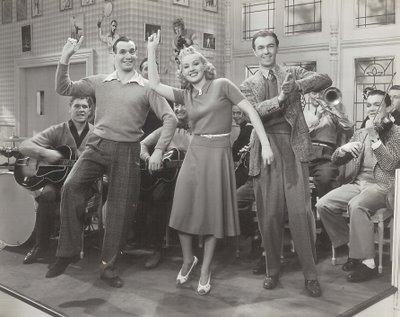
Jackie’s parents knew from nothing about a college education, but it seemed a reasonably good way to harness the young man’s excess energies, so it was off to Santa Clara University, where the most alarming episode of Jackie’s life, and the one most completely hidden from his public, took place. The year was 1933, and carefree Jackie was majoring in alcoholic studies and advanced cheerleading when he made friends with Brooke Hart, scion of a prominent Santa Clara family. During this era of sensational kidnappings, the public’s outrage was daily renewed by horrific incidents of abduction and murder (the Lindbergh case still fresh in collective memories). It was against this background that Brooke Hart was taken by a pair of local misanthropes, beaten to death, and thrown into a river before a ransom could be collected, a botched job down the line, but one which awakened mob frenzy with result both men were taken from their cell and hanged in the public square before a cheering crowd of 10,000 Santa Clara witnesses. Although he wasn’t photographed at the scene, there were plenty who recognized Jackie tying hemp to fulfill the deadly mission. Although he would never mention it during his lifetime (no one was ever prosecuted in connection with the incident), the truth of Coogan's involvement revealed itself in a "true crime" book, Swift Justice, which was published in 1992. Jackie’s own situation went from bad to worse when his father crashed the brand new Ford coupe he’d given Jackie for his twenty-first birthday, killing himself and three passengers. The only survivor was Jackie. His next crash would come in 1938 when he sued his mother and now stepfather, only to find they had converted all his fortune and left him stony. A bitter Coogan later told interviewers he had netted only $35,000 from the ordeal, out of the four million he earned as a child actor.

The single most enduring image of Jackie Coogan is the one he shared with Charlie Chaplin in The Kid. When Jackie went broke (the first of many such occasions), a sympathetic Chaplin spotted him ten G’s. Who says Charlie was stingy? At top stands Jackie and his expensively tailored parents on the Metro lot --- watch-chain, spats, and fur courtesy the child. Jackie wasn’t the title character in The Rag Man, but it seems he was always dressed in them. Audiences preferred him as ragamuffin, but Metro tried something different for two shown here in trade ads --- Long Live The King and Little Robinson Crusoe. Both are out of circulation today, though it’s rumored Warners preserved some Metro Coogans, but won't run them because of rights issues. Part of Jackie’s settlement with the crook parents gave him rights to negatives of these features. Is it possible his estate owns them yet? (he died in 1984) Maybe a meeting of minds between Warners and the Coogan family can put some of Jackie’s starring vehicles back in circulation. My online copyright search couldn’t turn up any reference to them. Orphan movies, just like most of Jackie’s roles. An exhibitor ad with Jackie in military garb came toward the end of his starring career. The Bugle Call and Buttons were both profitable, but talkies and adolescence, not to mention Louis Mayer’s antipathy, combined to scuttle him. Tom Sawyer at Paramount was a brand new Jackie, seen here with Mitzi Green and Junior Durkin, a close friend who would later die in that infamous wreck that killed Jack, Sr. Newlyweds Betty Grable and Jackie Coogan are whooping it up in College Swing. When someone asked her years later about the failed marriage to Jackie, Betty paid moving tribute when she said, "Listen honey, Coogan taught me more tricks than a whore learns in a whorehouse." You go, Jack!! Finally we have a couple of down-on-their-luck kid stars teaming up to pay the rent --- the Jackies Coogan and Cooper in Kilroy Was Here, a Monogram special they did in 1947. Coogan would have a comeback of sorts as Uncle Fester in The Addam’s Family, but the once beautiful boy hated playing it grotesque. The stardom of his youth was now so remote, he couldn’t even persuade his grown daughter of how big he’d once been. What a life this guy had. By far the best bio is one by Diana Serra Cary (a former child star herself) called Jackie Coogan --- The World’s Boy King, a terrific read.
My favorite piece on your site to date. Great visuals, little known information and a nice summary of somebody I thought I kind of knew but really didn't. Thanks.
ReplyDeleteYou wonder if his life would have really been any better if he did get all that money anyway.
ReplyDeleteWow, excellent piece. I knew about his family stealing all his money, but had no idea about the lynching, the Betty Grable quote, etc. Great research and presentation!
ReplyDeleteI watched Jack Coogan Sr in Roscoe Arbuckle's "Backstage" the other day and I must say he was impressive.
ReplyDelete